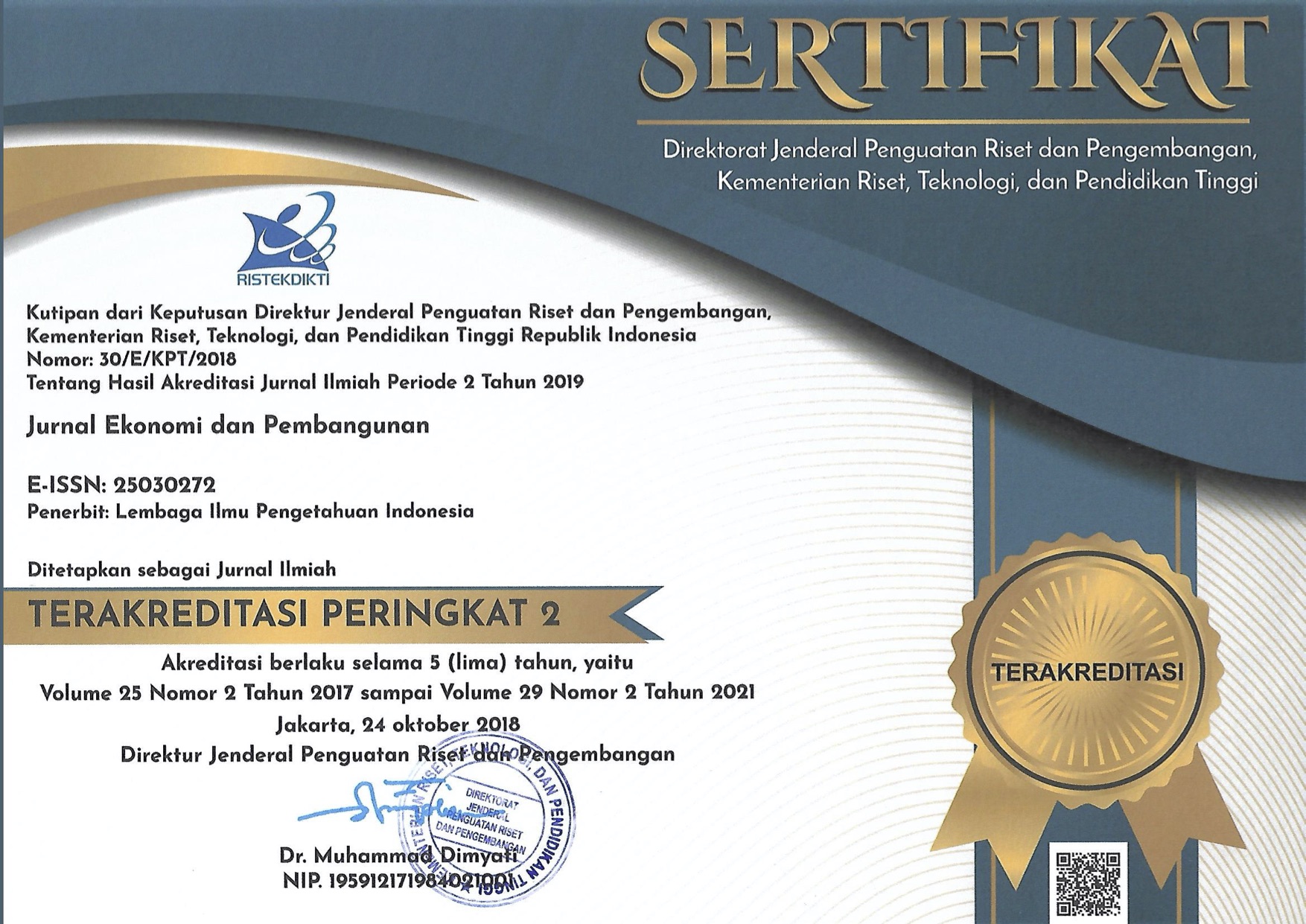Analyzing Factors Affecting Indonesian Food Price Inflation
Abstract
In the last decade, inflation in Indonesia dominantly influenced by volatile food (consists mostly of food commodities) and administered price, the core inflation has been relatively stable. The food contribution in the Living Cost Survey (SBH) has a substantial contribution in order to measuring the inflation. This paper aims to analyze empirical condition how the pattern of food price with other commodities price, particularly on energy commodities (housing and transportation). Using monthly series of consumer price index from 2004 to 2017 with 168 series total observation, we estimated a vector error-correction model (VECM). With assumption that the prices variable in estimation process have perfect information, the paper shows that the major drivers of Indonesian food price inflation are the food itself up to the two previous periods by the demand supply interaction rather than housing and transportation prices. Therefore, the authorities of inflation controlling are likely to be focus on maintaining the supply and demand of food commodities to control food price inflation.
Downloads
References
Bank Indonesia (2014) ‘Penghitungan Inflasi Berdasarkan Survei Biaya Hidup (SBH) Tahun 2012.’
Bima, J. J. A. (2017) Analisis Keterkaitan Inflasi antar Kelompok Komoditas Barang/Jasa di Jawa Tengah Tahun 2009.1-2015.12. Universitas Diponegoro.
Boediono (1992) Seri Sinopsis Pengantar Ilmu Ekonomi No.5: Ekonomi Moneter. 3rd edn. Yogyakarta: BPFE Yogyakarta.
BPS (2018) Statistik Dasar mengenai Kemiskinan. Available at: https://www.bps.go.id/subject/23/kemiskinan-dan-ketimpangan.html#subjekViewTab3.
BPS (2020) Diagram Timbang Indeks Harga Konsumen Hasil Survei Biaya Hidup 2018 Buku 1. Available at: https://www.bps.go.id/publication/2020/03/27/41e9992d045969fe278f1740/diagram-timbang-indeks-harga-konsumen-hasil-sbh-2018--buku-1.html.
Engle, R. F. and Granger, C. W. J. (1987) ‘Co-Integration and Error Correction: Representation, Estimation, and Testing’, Econometrica, 55(2), p. 251. doi: 10.2307/1913236.
Fatma, F. S. (2005) Pengaruh Inflasi dan Pengangguran terhadap Kemiskinan di Indonesia. Universitas Indonesia.
Fujii, T. (2013) ‘Impact of food inflation on poverty in the Philippines’, Food Policy, 39, pp. 13–27. doi: 10.1016/j.foodpol.2012.11.009.
Gujarati, D. N. and Porter, D. C. (2012) Dasar-dasar Ekonometrika. Edisi 5, B. Jakarta: McGraw-Hill Education (Asia) dan Salemba Empat.
Irz, X., Niemi, J. and Liu, X. (2013) ‘Determinants of food price inflation in Finland-The role of energy’, Energy Policy, 63, pp. 656–663. doi: 10.1016/j.enpol.2013.09.023.
Johansen, S. (1991) ‘Estimation and Hypothesis-Testing of Cointegration Vectors in Gaussian Vector Autoregressive Models’, Econometrica, 59(6), pp. 1551–1580. Available at:
Norazman, U. Z., Khalid, H. and Ghani, G. M. (2018) ‘Food inflation: A study on key determinants and price transmission processes for Malaysia’, International Journal of Business and Society, 19(1), pp. 117–138.
Ramadhan, G. (2009) ‘Analisis Keterkaitan Harga Antar Kelompok Komoditas Pembentuk Inflasi di Sumatera Barat’, Bank Indonesia.
Rehman, F. U. and Khan, D. (2015) ‘The Determinants of Food Price Inflation in Pakistan: An Econometric Analysis’, Advances in Economics and Business 3, 12, pp. 671–576.
Stock, J. H. and Watson, M. W. (2005) ‘Implications of Dynamic Factor Models for VAR Analysis’, NBER Working Paper Series, 11467, pp. 1–67. doi: 10.2139/ssrn.755703.
Copyright (c) 2020 Jurnal Ekonomi dan Pembangunan

This work is licensed under a Creative Commons Attribution-NonCommercial-ShareAlike 4.0 International License.
Terms and Conditions of Publication
1. Author's Rights and Authorities
As an author, you (or your employer or institution) may do the following:
-
make copies (print or electronic) of the article for your own personal use (not for commercial purpose), including for your own classroom teaching use;
-
make copies and distribute such copies (including through email) of the article to research colleagues, but not allowed to distribute commercially and systematically, e.g. via an email list or list server;
-
present the article at a meeting or conference and to distribute copies of the article to the delegates attending such meeting;
-
retain all proprietary rights in any process, procedure, or article of manufacture described in the work;
-
include the article in full or in part in a thesis or dissertation;
-
use the article or any part thereof in a printed compilation of your works, such as collected writings or lecture notes, and other derivative works, with full acknowledgement to JEP as the original journal publishing the article;
-
may reproduce material extracted from the article or derivative works for the author's personal use, but must consider the copyrights procedure.
All copies, print or electronic, or other use of the paper or article must include the appropriate bibliographic citation for the article’s publication in the journal.
2. Requests from Third Parties
Although authors are permitted to re-use all or portions of the article in other works, this does not include granting third-party requests for reprinting, republishing, or other types of re-use. Requests for all uses not included above, including the authorization of third parties to reproduce or otherwise use all or part of the article (including figures and tables), should be referred to P2E-LIPI by going to our website at http://ekonomi.lipi.go.id/.
3. P2E LIPI Copyright Ownership
Economic Research Center, the Indonesian Institute of Sciences (P2E-LIPI) owns the copyrights to reproduce, distribute, disseminate, translate, and other uses in accordance with the existing Laws and Regulations.
Every accepted manuscript should be accompanied by "Copyright Transfer Agreement" prior to the article publication.

This work is licensed under a Creative Commons Attribution-NonCommercial 4.0 International License.
JEP Journal by P2E-LIPI is licensed under a Creative Commons Attribution-NonCommercial-ShareAlike 4.0 International License. Permissions beyond the scope of this license may be available at http://jurnalekonomi.lipi.go.id/index.php/JEP
If you are a nonprofit or charitable organization, your use of an NC-licensed work could still run afoul of the NC restriction, and if you are a for-profit entity, your use of an NC-licensed work does not necessarily mean you have violated the term.






